For those of you who don’t know, I recently traveled to Hawaii to visit my dear friend and travel-nurse extraordinaire Kelly, who is stationed in Maui until March. She arrived to the island in early December, and would send me short text messages from time to time to entice me to visit. One such text message simply said “I saw whales today!” and I dismissed it. She might as well have said “Today I saw a shooting star.” Something remarkable, yes. But a whale, much like a shooting star, seemed a fleeting, faraway phenomenon. Not something I could count on.
Phenomenal, yes. Fleeting, no.
Why anyone would plan a trip to Hawaii and not time it during the winter months of December to April, peak humpback whale season in the warm, blue waters surrounding the islands, is beyond comprehension. Hawaii is a beautiful place, sure, the subject of lure and setting for cheesy Elvis Presley movies. The presence of the humpback whales, however, transcends it from a beautiful place to a magical place.
The first time I saw a whale, I was sitting alone and reading on Maui’s modest Kalepolepo Beach in Kihei just before sunset. I detected a rushed, excited change in tone in the conversations of scattered groups around me. They were charged. I looked up from my book to see what the commotion was, and saw fingers. Fingers pointing out into the water and suddenly, the loud, white, tell-tale plume of vapor of whale breath emerged before my eyes and I nearly screamed. I would quickly learn that this was the trick to whale-watching. Sit. Wait for other people to freak out. I tracked the movement with binoculars but it was not enough. I was transfixed. I wanted more.
The next day I arranged a whale-watch cruise with The Pacific Whale Foundation. I chose the no-frills Whale-Watch Special, which left from Ma’alaea Harbor at 12:30pm for $24.95 plus some nominal harbor fees. You do get a 10% discount if you book ahead online. I was told that since many people on vacation in Hawaii would rather cruise early morning or pre-dinner (leaving their day free to beach or golf), that the midday cruises (which the PWF call the “Special”) are discounted even further. A whale sighting is guaranteed, and the money you spend on the cruise is channeled right back into conservation and education, as the Pacific Whale Foundation is a nonprofit organization.
What I can tell you, without hesitation or exaggeration, that this was one of the best travel experiences I have ever had in my entire life, on par even with my African safari.
I think we all as travelers relish that moment of awe when we are confronted by something so much bigger than ourselves. That moment, for me, arrived quite literally when, after 10 minutes of sailing out from Ma’alaea, we confronted a “male competition” pod of humpback whales trying to capture the attention of a nearby lady whale. Suddenly, our boat pulled alongside four 30-ton whales slapping and thrashing about, in one of the most stunning displays of natural behavior I have ever borne witness. This was some real National Geographic shit.
Humpback whales migrate every winter the 3,000 miles from Alaska to the warm ocean outside of Hawaii for two reasons only: to have babies and to make babies. The naturalist on board, in addition to spotting the whales, expertly answered all manners of questions we had about them. (One of the more compelling reasons to choose the Pacific Whale Foundation for your whale-watching cruise as opposed to the countless others advertising their services on the streets of Maui, if you’re not already moved by the their mission to protect the endangered animals, is because of the on-board naturalist. Ours was fantastic, knowledgeable, and most impressively passionate.) The naturalist explained that Maui’s ocean is clear and blue, and the reason it is so clear and blue is that it is completely free of nutrients. This underscores the simple fact of their Hawaiian mission. The whales do not eat while they convene in Hawaii. They just do a whole lot of getting-it-on.
For all their force and magnitude, she also explained, the humpback whales are peaceful creatures. Though the male competition pod looked impressively violent, the whales never kill one another. Unlike their counterparts in other animal kingdoms (notably the lion), the male whales never kill calves fathered by other whales. This might be because female whales can breed immediately after giving birth. (I know, jeez.) To finish the cruise, the naturalist dropped a microphone into the water, and played the melancholic, haunting song of the whales nearby, and again I was awed. I had to keep reminding myself that it was all really happening.
Humpback whales are not particularly beautiful animals. They are rather like aliens of the ocean; they are terrifically large and spend all of their time under water and yet they are mammals, having to surface at least every 20 minutes to breathe the same air we do. Barnacle-ly and blubbery, they inhabit the same planet as us and yet I can consider myself incredibly lucky to have encountered one.
The next day, on a high from my whale-watching cruise, I headed up to the lookout point on Honoapiilani Highway near mile-marker 9 (going toward Lahaina from Ma’alaea, after the lighthouse but before the tunnel) where I stood, mesmerized for hours watching the seemingly hundreds of whales in the distance. The Pacific Whale Foundation also has a naturalist stationed at the lookout point, complete with informative literature, an umbrella to shade whale-watchers from the sun, and a few pairs of binoculars ready to be loaned out (for free!). They also keep a wipe-board listing all of the behaviors witnessed so far that day. The views from up there and from the lighthouse are extraordinary and offer a perfect conclusive “big picture.” Tip: the lighthouse viewpoint was less crowded and had more space – pack a beach chair, binoculars, sunblock and camp out a while! If you’re really lucky, you’ll see a breach!

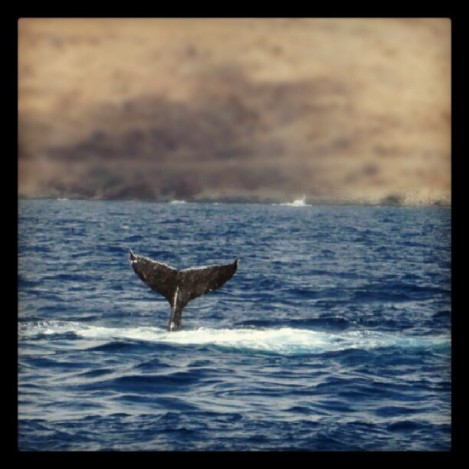
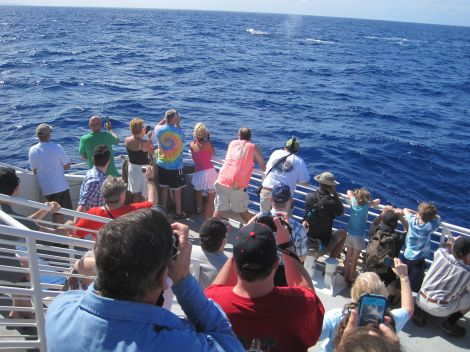
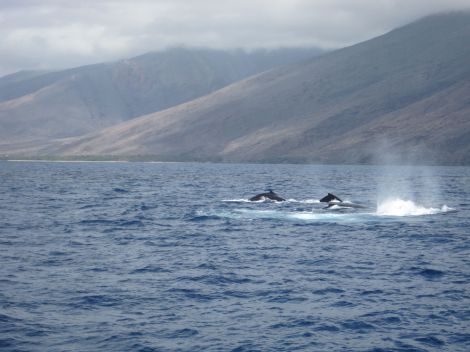
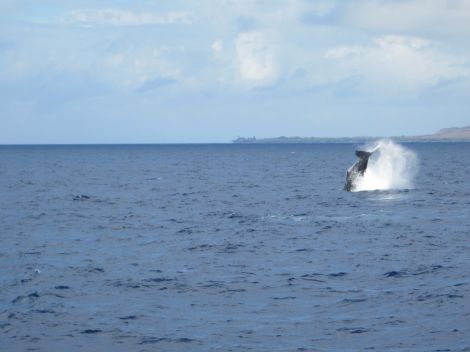
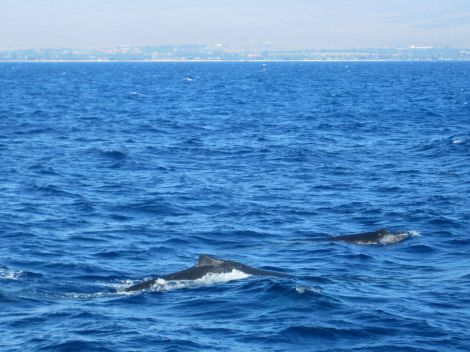
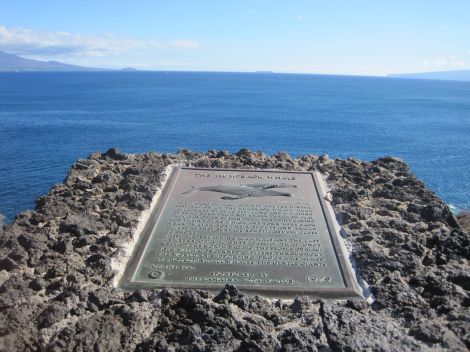
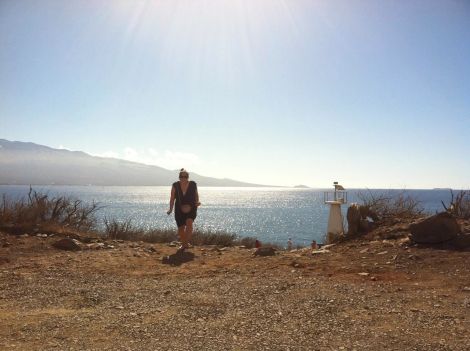
I enjoy seeing the places your travels take you to especially since I probably will never see them first hand. nfb
Now I really need to go to Hawaii! fantastic photos -glad you enjoyed the trip
We saw whales in New Zealand but Maui is stunning and would be such a great setting for this!
Your posting gave me chills. My friend and I are on our way to Maui on 2/14. I have gone to Maui every year for many years but in late October and miss the whales. The Pacific Whale Foundation is my choice always for snorkel or dolphin trips. This is my first time during peak whale season. I’m so happy for you that you got to experience this. This is also the first time I have every posted on a blog. Thank you for your words.
Thank you for sharing your experience. You did a beautiful job putting into words how it feels to see the whales. My son lives in Lahaina. I will be leaving in a couple of weeks for my 7th trip in February. I am hooked! Humpbacks are amazing animals! Two years ago I saw a baby whale being born near Baby Beach in Lahaina. It was so exciting! Two whales were close by the beach. They barely moved for almost an hour, logging. The female then very gently pushed her tail up and down in the water for about 10 minutes. Just then little baby spouts started. It was one of the most exciting things I have ever seen! I hope it will will be one of the last memories to leave me when they all start to go! It is “whale soup” out there right now. I can hardly wait to leave!
An unforgettable experience that absolutely changes you. Loved your story.
Time to go again…..miss the whales.
I was there over Christmas and also saw the whales. Unfortunately, I lack the talent to describe the experience as eloquently as you did. I can however attest to the fact it is as awe inspiring as you have described. I particularly enjoyed the fact the PWF naturalists were just as excited as the first time viewers. I cannot wait to go back!
Pingback: Haleakalā: Come for the sunrise, stay for the extraterrestrial | amanda elsewhere·